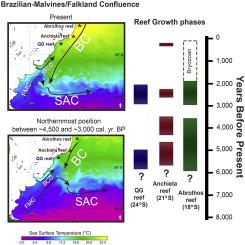Global and Planetary Change ( IF 4.0 ) Pub Date : 2021-04-02 , DOI: 10.1016/j.gloplacha.2021.103479 Guilherme H. Pereira-Filho , Vinícius R. Mendes , Chris T. Perry , Gustavo I. Shintate , Willians C. Niz , André O. Sawakuchi , Alex C. Bastos , Paulo César F. Giannini , Fabio S. Motta , Christian Millo , Gustavo M. Paula-Santos , Rodrigo L. Moura

|
Whilst the impacts of climatic and oceanographic change on lower latitude reefs are increasingly well documented, our understanding of how reef-building has fluctuated in higher latitude settings remains limited. Here, we explore the timing and longevity of reef-building through the mid- to late Holocene in the most southerly known reef (24°S) in the Western Atlantic. Reef core data show that reef growth was driven by a single coral species, Madracis decactis, and occurred over two phases since ~6000 calibrated (cal.) yr B.P.. These records further indicate that there was a clear growth hiatus from ~5500 to 2500 cal. yr B.P., and that there is no evidence of reef accretion on the Queimada Grande Reef (QGR) over the past 2000 yrs. It thus presently exists as a submerged senescent structure colonized largely by non-reef building organisms. Integration of these growth data with those from sites further north (18°S and 21°S) suggests that Intertropical Convergence Zone (ITCZ), South Westerlies Winds (SWW) and El Niño-Southern Oscillation (ENSO) variability and shifts during the Holocene drove changes in the position of the Brazil-Falklands/Malvinas Confluence (BFMC), and that this has had a strong regional influence on the timing and longevity of reef growth. Our results add new evidence to the idea that reef growth in marginal settings can rapidly turn-on or -off according to regional environmental changes, and thus are of relevance for predicting high latitude reef growth potential under climate change.
中文翻译:

极限生长:礁石生长对西南大西洋气候和海洋变化的敏感性
尽管越来越多地记录了气候和海洋变化对低纬度珊瑚礁的影响,但我们对高纬度地区珊瑚礁建设如何波动的理解仍然有限。在这里,我们探讨了在西大西洋最南端已知的珊瑚礁(24°S)中,从全新世中期到晚期建造珊瑚礁的时间和寿命。珊瑚礁核心数据显示,珊瑚礁的生长是由单一的珊瑚物种(麦德莱克氏菌)驱动的。,并且自〜6000年校准(cal。)BP以来,分两个阶段发生。这些记录进一步表明,从〜5500到2500 cal,有明显的生长裂隙。BP,并且在过去的2000年中,没有任何证据表明大魁北克礁(QGR)上有礁石积聚。因此,它目前以淹没的衰老结构形式存在,该结构主要被非礁石建筑生物殖民。这些增长数据与更北端(18°S和21°S)站点的数据的整合表明,全新世期间的热带辐合带(ITCZ),西南风(SWW)和厄尔尼诺-南方涛动(ENSO)变异性和移动性推动了巴西福克兰/马尔维纳斯汇合处(BFMC)的位置变化,这对礁石生长的时间和寿命产生了强烈的区域影响。









































 京公网安备 11010802027423号
京公网安备 11010802027423号